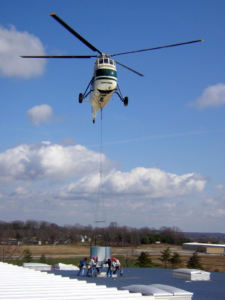Which Industrial Building Fan is Right for me?
Maintain the health and durability of your building by choosing the right industrial ventilation fan for your facility. Choosing the correct building fan is responsible for making sure that the facility has sufficient and consistent airflow. There are several factors that must be considered when choosing a building fan.
Building Fan Placement

The placement of your fans is determined by how large each fan should be and the number of fans you need. For example, if your facility needs ventilation in one isolated room, then installing one large upblast fan might be all you need.
Conversely, other larger facilities will require multiple fans across the roof to maximize air flow. Furthermore, it should be determined if any obstructions or cross breezes might reduce the effectiveness of a fan in each location. No matter how powerful the fan is if it’s in the wrong spot it will not be useful.
Fan Type
One of the most obvious decisions to make when choosing a fan is to select the type. The first choice is deciding between an axial fan and a centrifugal fan. Each has their specific uses, benefits, and drawbacks. Fortunately, Moffitt offers a variety of each type.
An axial fan works when you need to push a lot of air through a space. On the other hand, a centrifugal fan is good for moving smaller amounts of air more quickly from a small space. Think of it this way; Axial fans are what you use in your living room, while a centrifugal fan is what goes above your stove. Two different purposes, two distinct types. The team at Moffitt can help you find the right one for your facility.
How Big is your Space?
The size and shape of your facility will have a major impact on the powered fan that you need. Buildings of varied sizes will have different airflow needs. Be sure to accurately measure the room dimensions and building size, including height, to get a complete understanding of the building’s air volume and requirements.
The height of the ceiling is critical. Higher ceilings may require more powerful fans to have a sufficient impact on the work floor. Lastly, be mindful of your local building codes. Each region may have specific requirements for the size and number of powered fans. Make sure you account for the size of your work space when choosing fans.
Quality of the Building Fan
As your powered fan is an important investment for your facility, it is important to make sure that you invest wisely. While it may be tempting to purchase the cheapest fan available, this will cost you more in the long run. Smaller, budget fans tend to be less powerful, and therefore do not have the capacity to provide the airflow your large structure may need. This defeats the purpose of purchasing a fan in the first place. Choosing a high-quality, low-cost fan, like the ones Romlair has been manufacturing for decades, is the most important ventilation decision you can make.
Also, repairing and replacing fans gets expensive. From motors, to belts, to bearings, there are lots of moving parts. Making sure you have quality components from a reliable manufacturer is the key to ensuring the longevity of your building fan.
The Moffitt Difference
Finding the right ventilation fan for your facility can be challenging. That’s where Moffitt can help. The experts at Moffitt will make sure you get the right ventilation solution for your facility. Call us today to ask find the right building fan for your facility.
